



Government & Politics Unit 7 – Activities + Essays
43 items

Civil Rights and Civil Liberties | Government & Politics: Civics for the American Experiment
Video
Video
4 Min
What does it take to protect the rights of all citizens—and why does it matter? In this video, explore the foundations of civil rights in the United States and how individuals and institutions work together to uphold them.
From constitutional safeguards like checks and balances and the Bill of Rights to landmark amendments and court decisions, this video unpacks how civil rights have been defined, defended, and expanded. Discover the role of civic virtues and citizen action in advancing justice, with powerful historical examples from the Civil Rights Movement and beyond.
4 Min

Rights of the Accused Infographic
Activity
Activity
An interactive infographic that explain the Rights of the Accused.
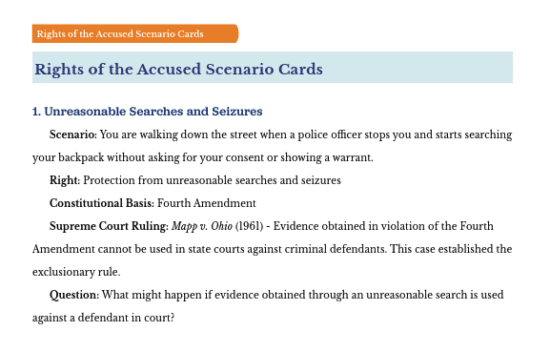
Rights of the Accused Scenario Cards
Activity
Activity
Explore the constitutional protections for individuals accused of crimes; each card presents a real-world situation, explains the relevant constitutional basis, and references key Supreme Court rulings.
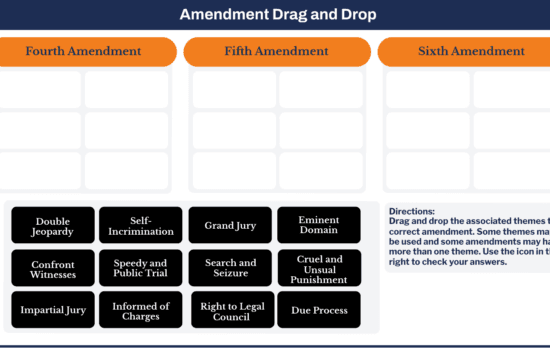
Amendments Four, Five and Six Interactive
Activity
Activity
A card sorting interactive that helps students define the fourth, fifth and sixth amendments.
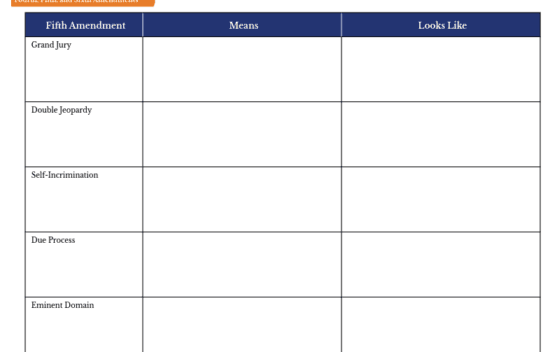
Fourth, Fifth, and Sixth Amendments Graphic Organizer
Activity
Activity
An organizer that helps divide the key components of the Fourth, Fifth, and Sixth amendments.
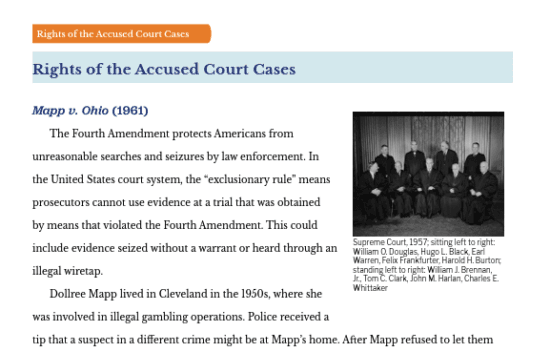
Rights of the Accused Court Cases
Activity
Activity
Case studies on landmark rights of the accused Supreme Court cases.
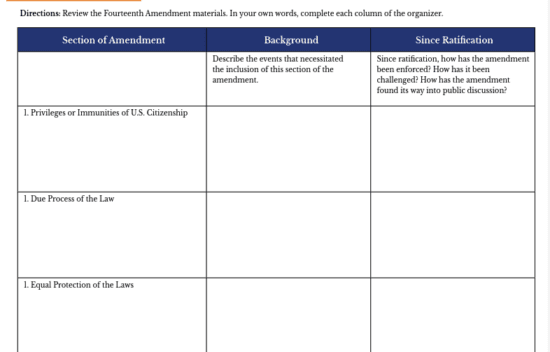
Fourteenth Amendment Graphic Organizer
Activity
Activity
A graphic organizer that helps divide the key components of the Fourteenth Amendment.
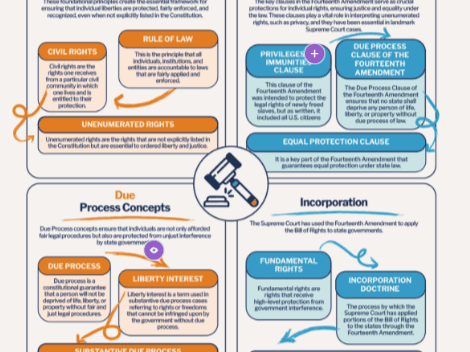
Substantive Due Process and the Fourteenth Amendment Infographic
Activity
Activity
A visual resource outlines essential terms, foundational concepts, and critical clauses related to the Fourteenth Amendment, with a focus on substantive due process.
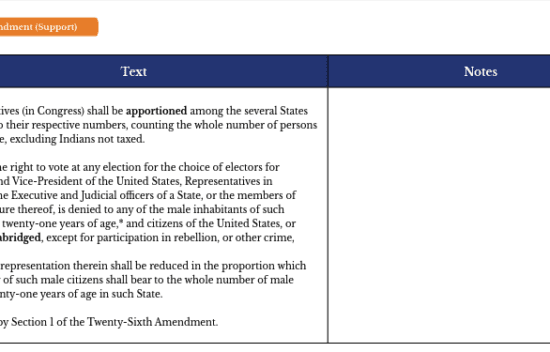
Fourteenth Amendment (Support)
Activity
Activity
A primary source activity analyzing the different sections of the Fourteenth Amendment.
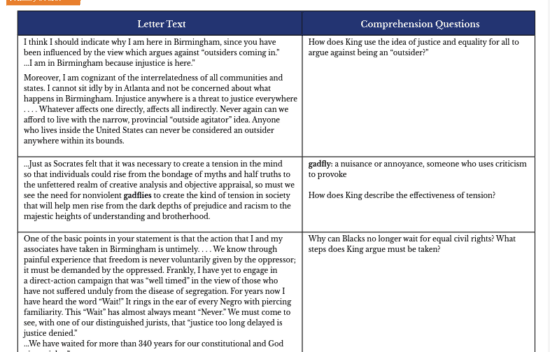
Letter From Birmingham Jail
Activity
Activity
The text of the letter, plus background information, and comprehension and analysis questions.
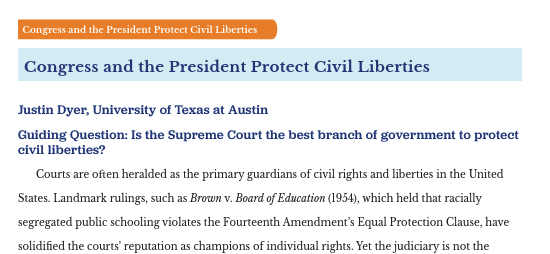
Congress and the President Protect Civil Liberties
Essay - 826 Words
Essay
826 Words
Is the Supreme Court the best branch of government to protect civil liberties?

Protecting Rights in a Free Society
Essay - 617 Words
Essay
617 Words
The structure of American constitutional government with limited government, separation of powers, and federalism is the best protector of the rights of the people.
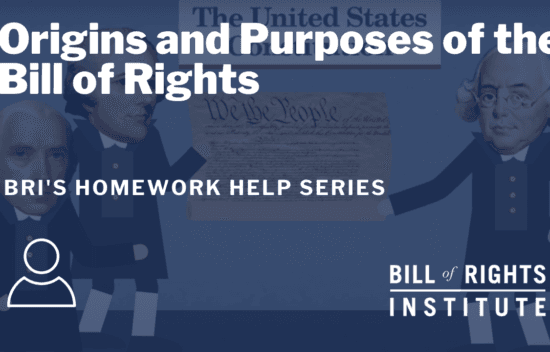
Origins and Purposes of the Bill of Rights | BRI’s Homework Help Series
Video
Video
6 Min
Why did the Founders see the need to create a Bill of Rights in addition to the US Constitution? What historical documents and events influenced them as they drafted it? The Virginia Declaration of Rights written by James Madison, the Magna Carta, the Petition of Rights, the English Bill of Rights, and the Massachusetts Body of Liberties.
The Founders included both concepts of democracy and republic in the blueprint for American government. Democracy protected majority rule whereas the idea of a republic protected individual citizens. The Bill of Rights was an important addition to the Constitution because it helped to guarantee individual rights. As a fluid document, inclusions to the Bill of Rights like the 14th Amendment brought the idea of incorporation, the process of states being held liable to uphold the Bill of Rights on the state level.
This latest installment in our Homework Help series explores these important constitutional questions.
6 Min

The Founding and the Natural Right of Religious Freedom
Essay - 944 Words
Essay
944 Words
A brief reading that explores the essential individual right of individual liberty and how it promotes civic virtues that help to preserve liberty.
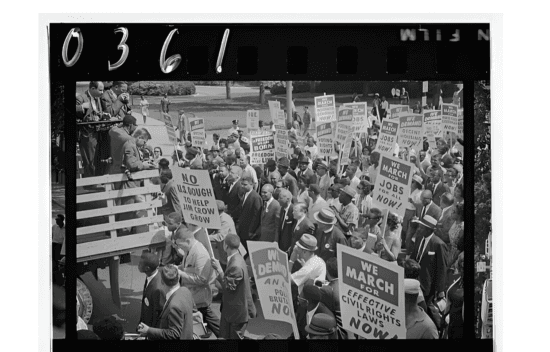
Civil Rights and Civil Liberties Image Collection
Activity
Activity
Images for students to explore as a part of the Civil Rights and Civil Liberties lesson.

Freedom of Religion Case Studies
Activity
Activity
Case studies on landmark freedom of religion Supreme Court cases.
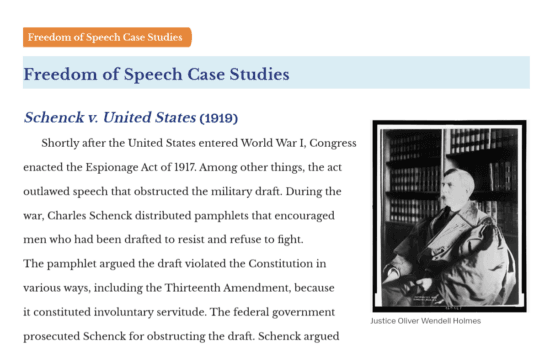
Freedom of Speech Case Studies
Activity
Activity
Case studies on landmark freedom of speech Supreme Court cases.

Freedom of Press Case Studies
Activity
Activity
Case studies on landmark freedom of the press Supreme Court cases.
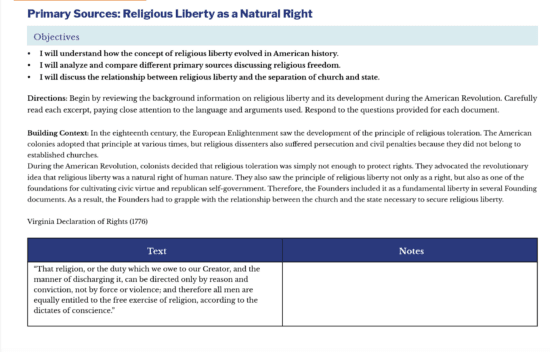
Primary Sources: Religious Liberty as a Natural Right
Activity
Activity
A collection of primary sources from the Founding that demonstrate the Founders believed religious liberty was a natural right.
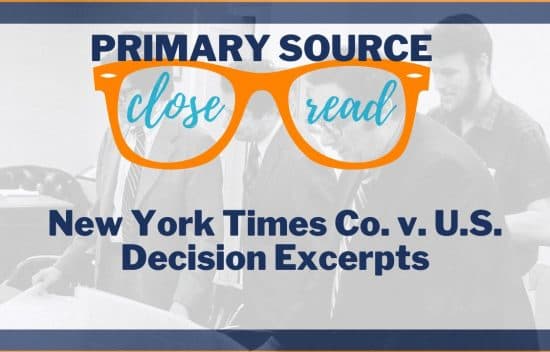
Reading New York Times Co. v. U.S. Decision Excerpts | A Primary Source Close Read w/ BRI
Video
Video
33 Min
In the midst of the Vietnam War, The New York Times released what the government considered to be highly sensitive information: the Pentagon Papers. In this video, Kirk Higgins and Joshua Schmid explore the Supreme Court case involving this matter, New York Times Company v. United States. How are we to balance the freedom of the press and our national security? To what extent can the government use its power of prior restraint to forcibly silence the press?
33 Min
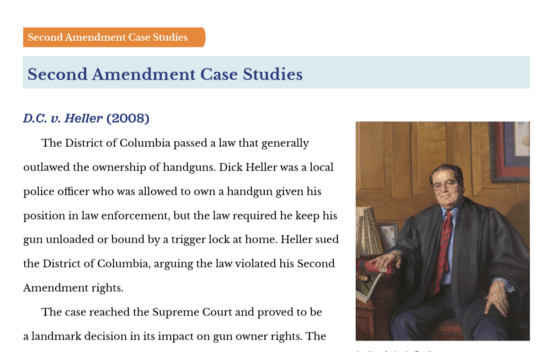
Second Amendment Case Studies
Activity
Activity
Case studies on landmark Second Amendment Supreme Court cases.
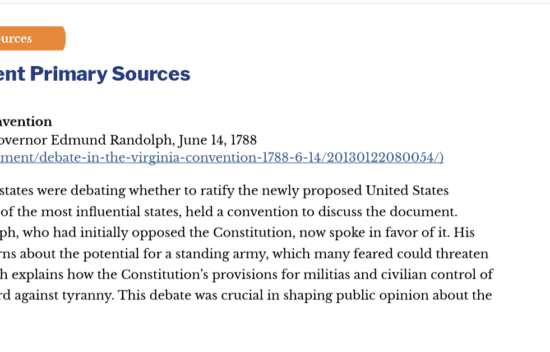
Second Amendment Primary Sources
Activity
Activity
Eight primary sources including Founding era documents and the text of the second amendment supreme case majority and dissenting opinions to help students analyze the Second Amendment.

The Second Amendment | BRI’s Homework Help Series
Video
Video
5 Min
What are the origins of the Second Amendment, and how has it been interpreted throughout U.S. history? This Homework Help video explores the history of the Second Amendment as well as the Supreme Court interpretations of it that shape current discussions on the topic of gun control.
5 Min
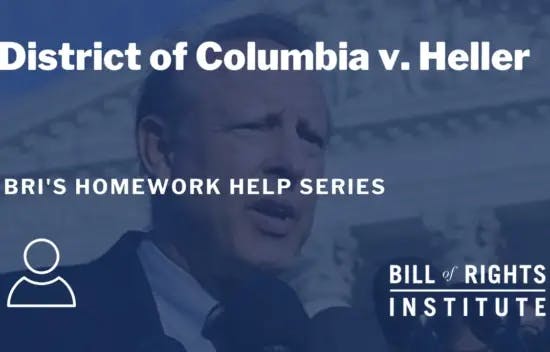
District of Columbia v. Heller | BRI’s Homework Help Series
Video
Video
Does the 2nd Amendment protect an individual or a collective right to bear arms? Find out the answer to this question in the latest episode of BRI's Homework Help Series on the case of District of Columbia v. Heller. 2008 Supreme Court case
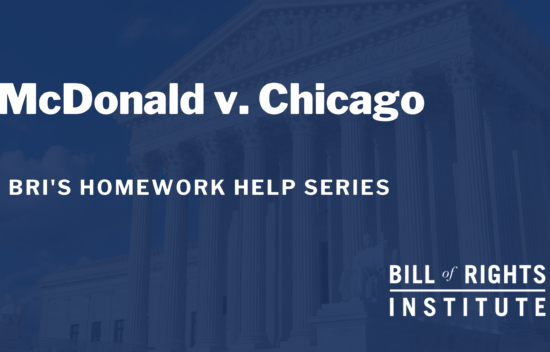
McDonald v. Chicago | Homework Help from the Bill of Rights Institute
Video
Video
4 Min
Does the Second Amendment prevent a city from effectively outlawing handgun ownership? In 2008, Otis McDonald attempted to purchase a handgun for self-defense purposes in a Chicago suburb. However, the city of Chicago had banned handgun ownership in 1982 when it passed a law that prevented issuing handgun registrations. McDonald argued this law violated the Fourteenth Amendment’s Privileges and Immunities Clause as well as the Due Process Clause. In a 5-4 decision, the Court ruled that McDonald’s Second Amendment right to bear arms was protected at the state and local level by the Due Process Clause of the Fourteenth Amendment.
4 Min
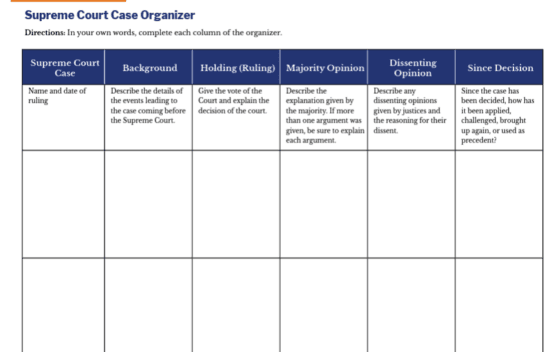
Supreme Court Case Organizer
Activity
Activity
A template to explore Supreme Court Cases related to the Fourth, Fifth, and Sixth amendments.
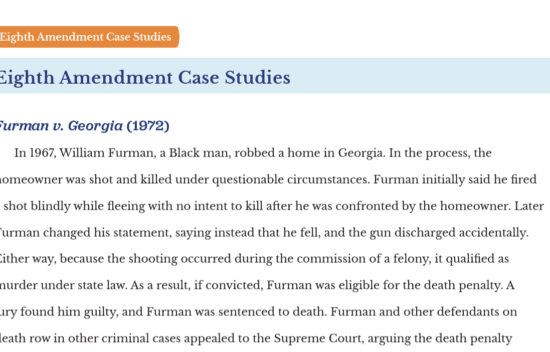
Eighth Amendment Case Studies
Activity
Activity
Case studies on landmark Eighth Amendment Supreme Court cases.
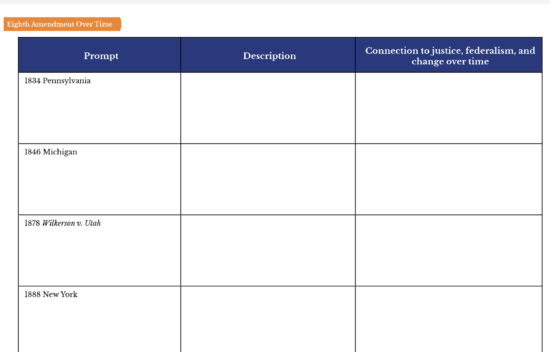
Eighth Amendment Over Time Graphic Organizer
Activity
Activity
A graphic organizer to engage students with the historical treatment of the death penalty from Jamestown Colony through the 21st century.
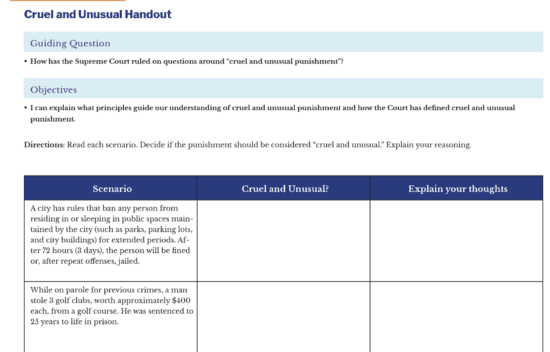
Cruel and Unusual Handout
Activity
Activity
A graphic organizer to help student organize material on Supreme Court cases focusing on the Eighth Amendment.

Supreme Court Decision Info Sheet
Activity
Activity
Background information on Supreme Court cases dealing with the Eighth Amendment.

The Fourth Amendment | BRI’s Homework Help Series
Video
Video
5 Min
What prevents the police from randomly searching our homes and possessions whenever they want? The Founders created the Fourth Amendment to protect the individual right to private property. Learn more about its origins and some landmark Supreme Court cases in our latest Homework Help video.
5 Min

The Fifth Amendment | BRI’s Homework Help Series
Video
Video
6 Min
What protections does the Fifth Amendment provide, and why did the Founders believe them important enough to enshrine in the Bill of Rights? Our latest Homework Help video explores these questions and provides students with a succinct overview of the essential information regarding this amendment.
6 Min

Sixth Amendment | BRI’s Homework Help Series
Video
Video
What protections exist for Americans accused of a crime? The 6th Amendment. What is the 6th Amendment?
The 6th Amendment provides defendants with rights to a speedy and fair trial, an impartial jury, and more. Our latest Homework Help video explores the 6th Amendment and provides students with a succinct overview of the essential information regarding this amendment.
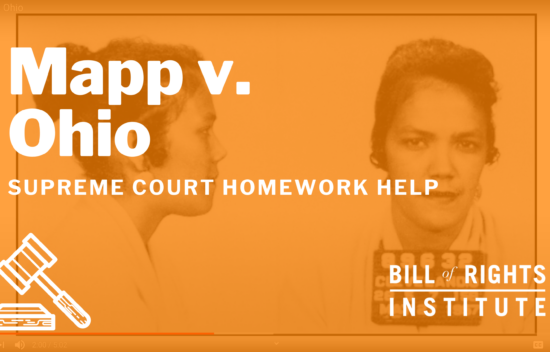
Mapp v. Ohio | BRI’s Homework Help Series
Video
Video
5 Min
Can the police use illegally seized evidence in a court of law? The landmark Supreme Court case Mapp v. Ohio addressed this issue, and the decision has had a lasting impact in the United States.
5 Min
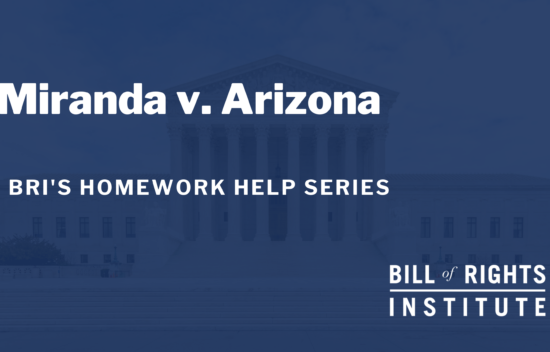
Miranda v. Arizona | BRI’s Homework Help Series
Video
Video
3 Min
Miranda v. Arizona was a case brought to the Supreme Court in 1966 after Ernesto Miranda appealed his guilty conviction of kidnapping and rape. In his appeal, Miranda claimed he was unaware of his right to remain silent and his resulting confession should not be used to incriminate him. The Supreme Court ruled in favor of Miranda and established the Miranda Warning. This warning is now recited in most instances of arrest to ensure the accused people are aware of their rights.
3 Min
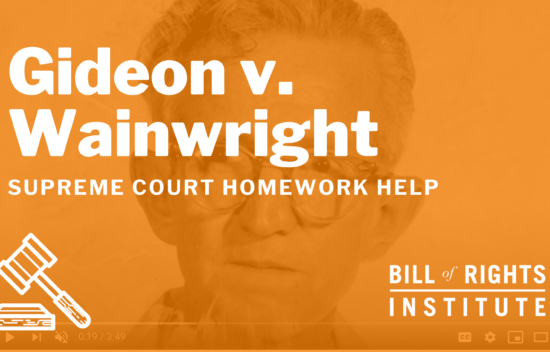
Gideon v. Wainwright | Homework Help from the Bill of Rights Institute
Video
Video
4 Min
Does an individual have a right to a lawyer, regardless of the crime he or she is charged with? In 1961, Clarence Gideon was arrested and charged with breaking and entering and petty larceny in Panama City, Florida. His request for a state-provided defense attorney was denied since Florida law only required doing so for capital offense cases. After Gideon was sentenced to 5 years in prison, he argued that Florida violated the 6th Amendment’s guarantee of the right to counsel. The Supreme Court heard Gideon’s case, in Gideon v. Wainwright, and ruled in a 9-0 decision that the 6th Amendment’s guarantee of an attorney applies to states through the Due Process Clause of the 14th Amendment through incorporation.
4 Min

Eighth Amendment | BRI’s Homework Help Series
Video
Video
How do we determine the punishment for those accused or convicted of a crime? What is the 8th amendment? Our latest Homework Help video explores this question and provides students with a succinct overview of the essential information regarding the 8th amendment.
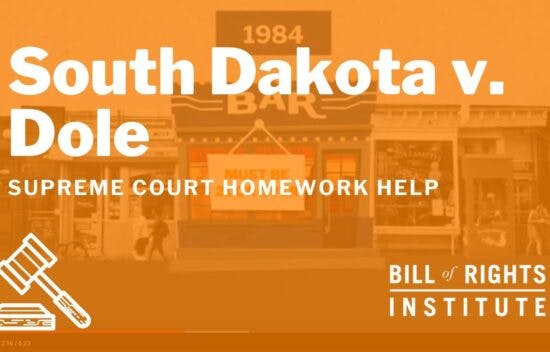
South Dakota v. Dole | BRI’s Homework Help Series
Video
Video
7 Min
Why is the drinking age set at 21? This Homework Help video explores the dispute between states and the federal government over the legal age, and how it is an example of the principle of federalism in action.
7 Min

Federalism | BRI’s Homework Help Series
Video
Video
5 Min
This Homework Help narrative explores the history of the Founding of the U.S. and the reasons why federalism was created as an important part of our constitutional system. The video challenges viewers to consider this question: why we have a system with local, state, and federal laws?
5 Min
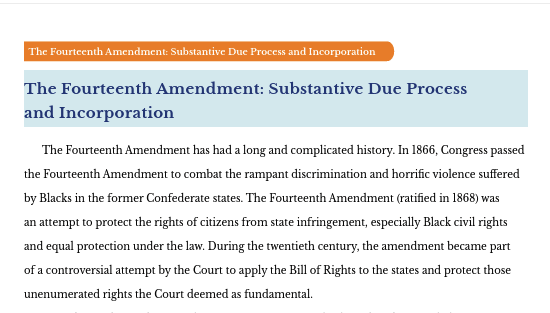
The Fourteenth Amendment: Substantive Due Process and Incorporation
Essay - 1280 Words
Essay
1280 Words
Survey the creation and intent of the Fourteenth Amendment and its incorporation by the Supreme Court.

Fourteenth Amendment Case Study
Activity
Activity
A case study using the on landmark substantive due process Supreme Court case, Roe v. Wade.

Incorporation | BRI’s Homework Help Series
Video
Video
4 Min
In this Homework Help narrative, learn about the constitutional principle of incorporation and its historic context. After the passage of the 14th Amendment, the Due Process Clause caused many national and state debates, leading to the idea of incorporation and the fundamental question of whether the Bill of Rights applies to states as well as the federal government.
Has incorporating the Bill of Rights to apply to the states created greater liberty for Americans?
4 Min
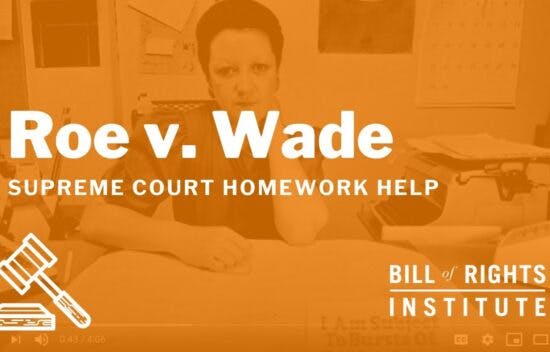
Roe v. Wade | Homework Help from the Bill of Rights Institute
Video
Video
4 Min
Do women have a right to privacy when deciding whether to have an abortion? In 1969, a woman under the alias “Jane Roe” challenged a Texas law that outlawed abortions. The case eventually reached the Supreme Court, where Roe argued that the Constitution protects a woman’s right to privacy in having an abortion. In a 7-2 decision, the Court ruled the right to an abortion fell within the right to privacy protected by the 14th Amendment’s Due Process Clause.
Like other Supreme Court cases related to the Due Process Clause, incorporation played a part in the Roe v. Wade ruling. Incorporation suggests that states must adhere to the protections granted in the Bill of Rights.
To this day, the ruling in Roe v. Wade remains one of the most controversial Supreme Court decisions.
4 Min